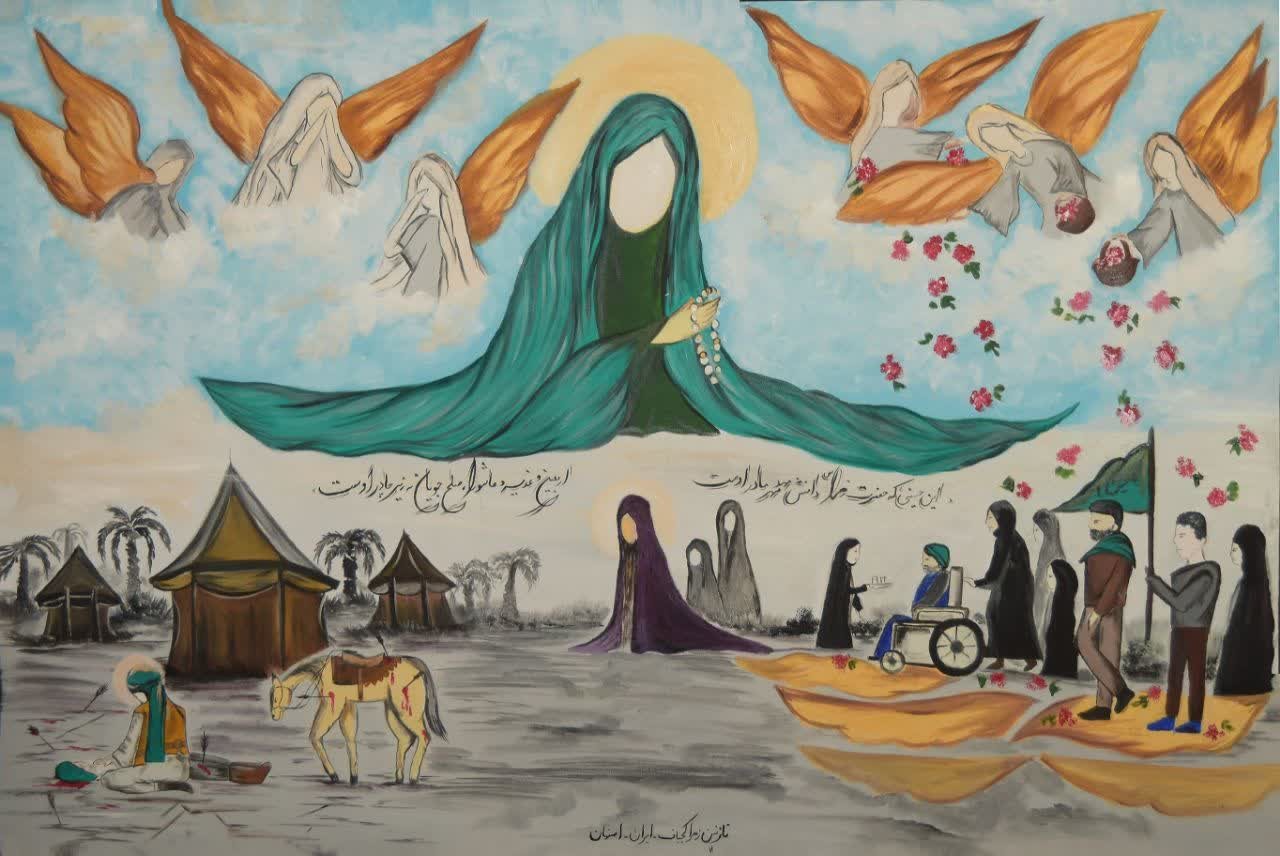was invited to Imam al-Husayn’s shrine to present an article, and I accompanied her. While Mom was presenting her article, I silently wished, “I wish I could do something for Imam al-Husayn and the Ahl al-Bayt.” A week later, Mom was in a group where a poster for an Arbaeen painting contest was shared The story began when my mother, Dr. Safoora Tork Ladani. She showed me the poster, and although I was excited, I also felt sad because I thought I might be too young to participate. I asked Mom to check with the contest organizers if a fourteen-year-old girl could enter. The next day, Mom inquired, and they replied that although the contest was designed for adults, I could still participate. The poster stated that the painting had to be done in color and oil on a 1x1.5 meter canvas, which seemed enormous. From that moment, I began preparing the equipment needed for painting. We visited four or five shops to buy the canvas, but none of them had it. Finally, we were directed to a shop downtown where it was available. I asked my older brother to help, and he went to the shop to purchase the canvas. It was so large that it couldn’t fit in the car, so we had to hire a van to bring it home. When the canvas arrived, I was thrilled and told myself I would start painting the next day. However, I was shocked when I saw its size—it was huge! Still, I didn’t lose heart and reminded myself that I could do it. The following day, Mom explained the subject you had in mind for the painting. She instructed me to portray three scenes: first, the scene of Karbala; second, Lady Zaynab’s arrival in Karbala on the first Arbaeen; and third, the Arbaeen processions involving various people and nations.
1. In the scene of Karbala, Imam al-Husayn stands over the body of Ali al-Akbar, weeping for the loss of his young and handsome son, who resembled the Prophet—the Prophet of mercy for all worlds, who always sought peace and love among people. Imam al-Husayn represents peace and freedom, being the grandson of the Prophet (peace be upon him and his household).
2. In the second scene, depicting Lady Zaynab’s entry into Karbala, she mourns for her brother while standing firm and resolute, alongside other women, to carry forward the message of Ashura.
3. The third scene signifies the enduring legacy of the school of Karbala, upheld not only by Shias but by all those in the world who seek freedom, compassion, and mutual assistance, such as hosting pilgrims. Ultimately, it represents the formation of a united Islamic Ummah in preparation for the reappearance of the promised Imam al-Mahdi.
Before starting, we sought the intercession of the Ahl al-Bayt and the Shiite Imams by reciting Hadith al-Kasa and Ziyara Ashura. During these two months, each time I prepared to paint, I would perform wudu first. Interestingly, whenever I painted, the stains of color on my hands felt pleasant to me, and I’m not sure why.
Let me also add that my grandfather is a poet. I asked him to compose a poem for this painting. It was challenging, but he eventually wrote:
This Husayn who is under the compassionate care of his mother, Zahra
Under her garment peacefully lie Arbaeen, Ghadir, and Ashura
When the painting was finished, I asked my teacher to write the poem on it. It was amusing that the painting was too large to fit inside the car, so we had to place it on the roof, with four of us holding it from the car windows. We did the same on the way back home. Once we arrived, we placed the painting near my room. My mom and I were planning to go to Arbaeen the following week. To prepare, we removed the canvas from its frame, rolled it carefully, and used adhesive tape and other materials to secure it. I felt a mix of sadness and joy—I was deeply attached to the painting, as if it were a part of me. At the same time, I was happy, knowing that I was dedicating it to Imam al-Husayn, even though it meant parting with something so precious to me. We arrived in Najaf and began our journey to Karbala with the painting. The painting accompanied us throughout our procession. The day after we arrived in Karbala, we circumambulated the painting around Imam al-Husayn’s shrine, and finally, we submitted it to the contest organizer.
It was a strange moment for me—a mix of joy and sadness.
When I was informed that my painting had been accepted, I couldn’t stop crying. I received the news while I was at school, attending a celebration for Imam al-Mahdi’s birthday anniversary. To surprise me, my parents had secretly given the certificate of appreciation from Imam al-Husayn’s shrine to the school. As the ceremony was ending, the deputy principal took the stage and announced, “There is someone in our school who has won the Arbaeen painting contest of Imam al-Husayn’s shrine.” I thought to myself, “Wow! That sounds so much like me!” She continued speaking, and then suddenly mentioned my name. “Me?” I asked, and they replied, “Yes, you!” I went up on stage, tears streaming down my face. My best friend came up and hugged me to calm me down. I was then presented with the certificate of appreciation. The other students exclaimed, “You had such talents?!” Everyone hugged me and congratulated me.
My prize was a plane trip to Iraq to participate in the Arbaeen Conference in August 2024. We were fully funded and hosted by Imam al-Husayn’s shrine, and they had also invited my parents for my sake. This was my story.
Nazanin Zahra Kajbaf
translated by Amenah Al Yasir

